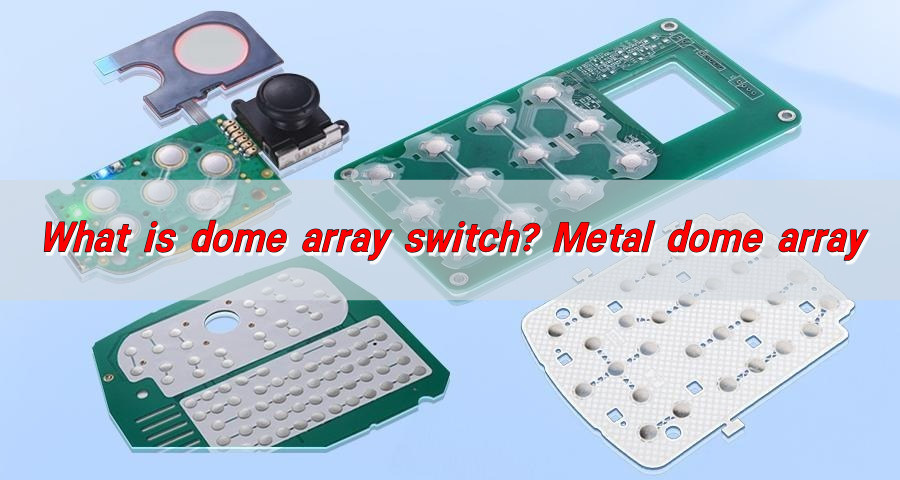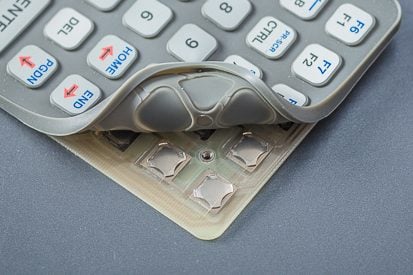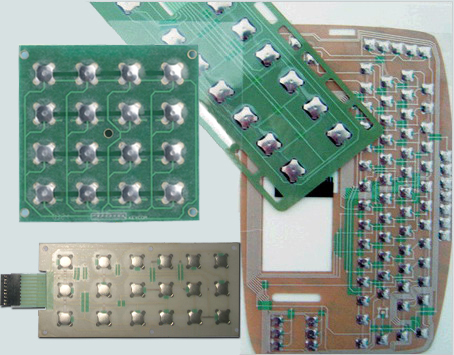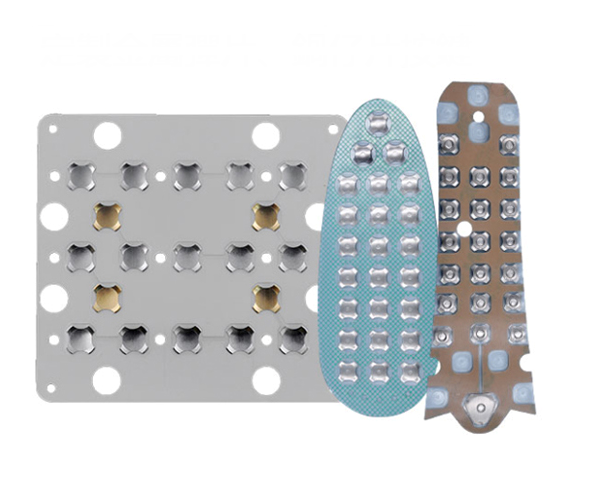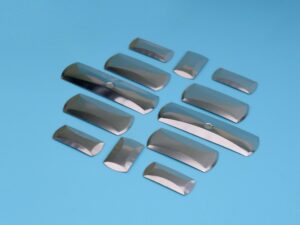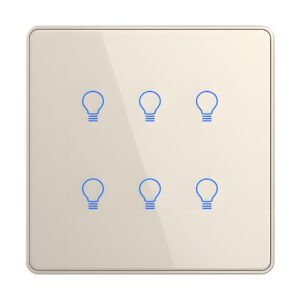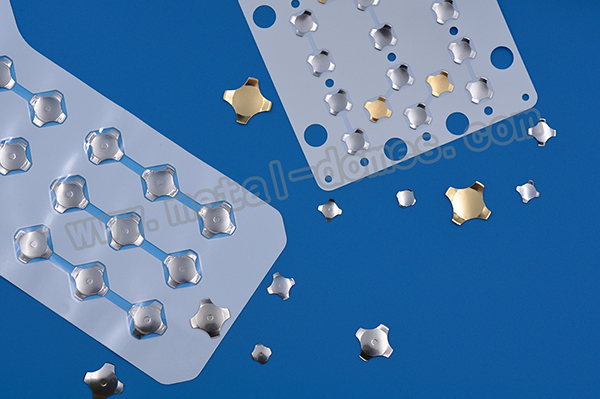The dome array switch is a membrane switch, the core of which is a metal dome array, which is a component composed of multiple metal dome arranged in a specific order, usually fixed on a PET substrate with a pressure-sensitive adhesive. Each metal dome is located in the center of a pre-cut square or circular adhesive layer, and is attached with a release substrate for quick peeling during assembly.
When the button is pressed, the dome contacts the circuit to achieve circuit conduction. When making the metal dome array, it is necessary to select suitable metal materials and make it through processes such as stamping and heat treatment. The key lies in the accuracy and elasticity of the dome to ensure the sensitivity and life of the switch.
What is a dome array switch?
Dome array switch is a type of tactile switch used in a wide range of electronic devices. Unlike traditional mechanical switches, which rely on individual key mechanisms, a dome array switch integrates multiple metal domes into a single, compact unit. These switches are often used in keypads, remote controls, and even some types of keyboards.
The switch works through a metal dome that, when pressed, collapses and completes the circuit, sending a signal to the device. This action is often paired with a tactile feedback mechanism, giving the user a satisfying “click” or “bump” when the switch is activated. This makes dome array switches highly effective in providing users with immediate feedback during interactions.
How do dome switch arrays work?
Dome switch arrays function through a clever arrangement of metal domes. These domes are placed on a flexible membrane or circuit board. When a user presses down on a key or button, the corresponding metal dome collapses. This collapses the switch’s internal structure and connects the electrical circuit. This action sends a signal to the device, informing it that the button has been pressed.
The key benefit of dome array switches is their simplicity and cost-effectiveness. By grouping multiple metal domes in an array, manufacturers can create compact and durable switches without increasing complexity or cost.
Additionally, the dome array switch provides excellent tactile feedback. The design of the metal dome ensures that each key press is noticeable. The “click” or “bump” generated by the metal dome is often seen as more satisfying than other types of switches.
What is a double metal dome array switch?
The double metal dome array (metal dome sheet) is similar to the single layer dome array, in that metal dome contacts are installed under the Maylar. But the difference is that, in this type, the Spacer is attached under the metal dome contacts.
Air paths which function like air holes in single-layer, helps provide good click-feeling when dome contacts are pressed. Besides this effect, air paths help reduce the chance for PET film being damaged by metal dome contacts’ burr and block dust coming into PET films.
We not only put several dome on a array, but also put just one piece per array, so that customer can just peel off each piece and put it on key location of Keyboard/ FPC/ PCB.
You can easily peel off the single metal dome array from release liner backing and adhere it firmly on your PCB, FPC or membrane switches, and we named it ” Standard Single Key Dome Array”.
Dome array switch vs. Mechanical switch: Which is better?
Both dome array switches and mechanical switches offer unique advantages, but the right choice largely depends on the specific needs of the user.
Dome array switches are often more affordable than mechanical switches, making them a cost-effective option for mass production. Their compact design and high durability make them a solid choice for various applications, including remote controls and calculators.
Mechanical switches, on the other hand, are known for their superior feel and longevity. They use individual key mechanisms with springs, giving them a distinct “clicky” or “smooth” feel, depending on the switch type.
How does a dome array switch improve performance?
Dome array switches improve performance in several key ways. First, their design allows for faster response times compared to older switch technologies. The metal dome’s collapse is quick, sending a signal almost instantaneously. This makes dome array switches ideal for devices that require quick feedback, such as remote controls or simple calculators.
Another way dome array switches enhance performance is by providing tactile feedback. The feedback from the metal dome allows users to know when a key has been pressed, reducing the chance of missed inputs. This tactile advantage improves overall efficiency, especially in devices where precision is important.
Additionally, dome array switches are designed for durability. The metal domes can withstand millions of key presses, making them long-lasting and reliable.
Why is my dome array switch not working?
While these switches are generally durable, issues can arise due to various factors.
- Dirt and Debris: Over time, dust, dirt, and other debris can build up inside the switch, preventing it from functioning properly.
- Wear and Tear: If the metal dome has been compressed too many times, it may lose its ability to collapse and complete the circuit.
- Circuit Damage: The underlying circuit board or membrane could be damaged, preventing the switch from activating.
- Poor Assembly: If the metal domes are not aligned correctly, or if the switch’s internal components are not assembled properly, it can cause malfunction.
Where should dome array switches be placed?
Dome array switches are versatile and can be used in a variety of devices.
For instance, in keypads and remote controls, dome array switches are typically arranged in a grid formation, with each key having its own metal dome. In this configuration, the switches are placed on a flexible membrane or printed circuit board (PCB) that can be easily integrated into the device.
In keyboards, dome array switches are often used in smaller, compact designs. They can be placed in specific locations to improve ergonomics or to provide users with a satisfying typing experience.
The placement of the switches should always prioritize user experience and ease of use. For maximum performance, the switches should be placed in positions that allow for easy, ergonomic access.
What are the key features of a dome array switch keyboard?
When incorporated into a dome array switch keyboard, these switches offer several key features that improve both performance and user experience:
- Compact Design: Dome array switches are often used in compact keyboard designs, allowing for smaller, lighter, and more portable devices.
- Tactile Feedback: The metal domes provide satisfying tactile feedback.
- Durability: These switches are designed to last, with metal domes that can withstand millions of presses without losing their functionality.
- Cost-Effective: Dome array switches are a cost-effective alternative to more expensive mechanical switches, making them an ideal choice for budget-friendly keyboard designs.
- Reliability: These switches offer reliable performance, even under heavy usage, ensuring consistent results over time.
Conclusion:
The dome array switch is an essential component in many electronic devices, providing users with a reliable, cost-effective, and durable solution. Whether you’re building a keypad, designing a keyboard, or working on any other electronic project, dome array switches offer impressive performance and tactile feedback.
For more information or if you have any questions, feel free to contact us at sales@metal-domes.com


